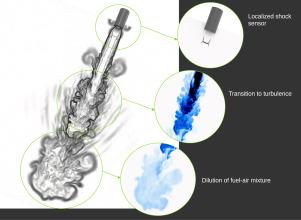用低耗散解算器模拟高度欠膨胀氢射流的大涡
IF 8.3
2区 工程技术
Q1 CHEMISTRY, PHYSICAL
引用次数: 0
摘要
在喷嘴压力比5.8≤NPR≤10的条件下,对H2射流进行了大涡模拟。提出了一种低耗散、局部化的通量公式,并使用1D-3D参考案例进行了验证。在目前的欠膨胀射流研究中,进行了以下数值观测。(1)提出的低耗散方法同时解决了冲击和湍流。注意到,与完全耗散通量方法相比,低耗散方法下的欠膨胀射流向湍流的过渡开始时间早于≈10D。(2) H2、CH4和N2射流的对比表明,在NPR = 6.5时H2向湍流的过渡延迟。(3)在所有NPR下,H2射流湍流过渡都被延迟,但随着NPR的增大,H2射流湍流过渡向喷嘴方向转移。(4) H2射流在桶形激波边界处Görtler涡的归一化峰值涡量(ωzD/U1)值比代表性的CH4和N2射流低约4倍。(5)对于H2,观测到马赫盘振荡,并在St≈0.063−0.078的Strouhal数范围内与全局POD模态相关联。本文章由计算机程序翻译,如有差异,请以英文原文为准。

Large-Eddy simulation of highly under-expanded hydrogen jets using a low dissipative solver
Large-eddy simulation (LES) of H2 jets is carried out at nozzle pressure ratios 5.8 NPR 10. A low-dissipative, localized flux formulation is proposed and validated using 1D–3D reference cases. In the present under-expanded jet studies, the following numerical observations are made. (1) The proposed low-dissipative approach resolves both shocks and turbulence simultaneously. The transition to turbulence is noted to start up to earlier for under-expanded jets with low-dissipative approach in comparison to the fully dissipative flux approach. (2) A comparison of H2, CH4, and N2 jets indicates a delayed transition to turbulence for H2 at NPR = 6.5. (3) At all NPRs, the H2 jet turbulence transition is delayed, but the transition shifts towards the nozzle when the NPR increases. (4) The normalized peak vorticity values for Görtler vortices around the barrel shock boundary of H2 jet is observed to be times lower compared to representative CH4 and N2 jets. (5) For H2, Mach disk oscillation is observed and linked to the global POD modes at a Strouhal number range of .
求助全文
通过发布文献求助,成功后即可免费获取论文全文。
去求助
来源期刊

International Journal of Hydrogen Energy
工程技术-环境科学
CiteScore
13.50
自引率
25.00%
发文量
3502
审稿时长
60 days
期刊介绍:
The objective of the International Journal of Hydrogen Energy is to facilitate the exchange of new ideas, technological advancements, and research findings in the field of Hydrogen Energy among scientists and engineers worldwide. This journal showcases original research, both analytical and experimental, covering various aspects of Hydrogen Energy. These include production, storage, transmission, utilization, enabling technologies, environmental impact, economic considerations, and global perspectives on hydrogen and its carriers such as NH3, CH4, alcohols, etc.
The utilization aspect encompasses various methods such as thermochemical (combustion), photochemical, electrochemical (fuel cells), and nuclear conversion of hydrogen, hydrogen isotopes, and hydrogen carriers into thermal, mechanical, and electrical energies. The applications of these energies can be found in transportation (including aerospace), industrial, commercial, and residential sectors.
 求助内容:
求助内容: 应助结果提醒方式:
应助结果提醒方式:


